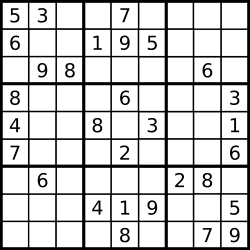Description
Given n pairs of parentheses, write a function to generate all combinations of well-formed parentheses.
For example, given n = 3, a solution set is:
[ "((()))", "(()())", "(())()", "()(())", "()()()" ]
给出n组括号,生成所有正确的匹配组合
Given n pairs of parentheses, write a function to generate all combinations of well-formed parentheses.
For example, given n = 3, a solution set is:
[ "((()))", "(()())", "(())()", "()(())", "()()()" ]
给出n组括号,生成所有正确的匹配组合
Letter Combinations of a Phone Number
Given a digit string, return all possible letter combinations that the number could represent.
A mapping of digit to letters (just like on the telephone buttons) is given below.

Input: Digit string "23" Output: ["ad", "ae", "af", "bd", "be", "bf", "cd", "ce", "cf"].
输入九宫格输入法数字,输出对应的所有字母组合
The n-queens puzzle is the problem of placing n queens on an n×n chessboard such that no two queens attack each other.
Given an integer n, return all distinct solutions to the n-queens puzzle.
Each solution contains a distinct board configuration of the n-queens' placement, where
'Q'and'.'both indicate a queen and an empty space respectively.
Write a program to solve a Sudoku puzzle by filling the empty cells. Empty cells are indicated by the character ‘.’. You may assume that there will be only one unique solution.

Implement regular expression matching with support for ‘.’ and ‘*’.
'.' Matches any single character. '*' Matches zero or more of the preceding element. The matching should cover the entire input string (not partial). The function prototype should be: bool isMatch(const char *s, const char *p) Some examples: isMatch("aa","a") → false isMatch("aa","aa") → true isMatch("aaa","aa") → false isMatch("aa", "a*") → true isMatch("aa", ".*") → true isMatch("ab", ".*") → true isMatch("aab", "c*a*b") → true